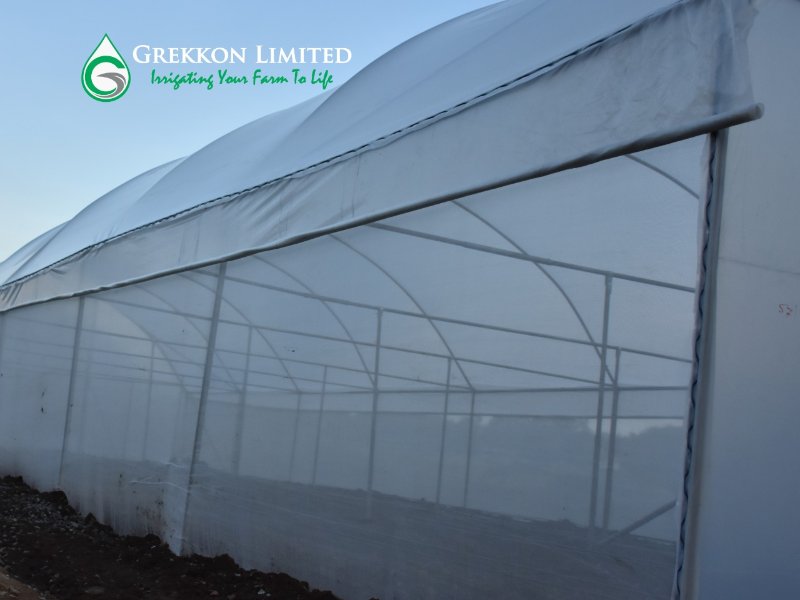
Greenhouse Paper In Kenya
Grekkon Limited’s greenhouse paper in Kenya is of various rent characteristics. These characteristics determine it’s overall performance on the crop. The paper choice is the same irrespective of the greenhouse type by shape, or by structural material. Our greenhouse paper price in Kenya is Kes 96/M sq irrespective of the polythene properties
Greenhouse Paper In Kenya; Properties
- Thickness. 200 microns/ 0.2mm
- Colour . Clear or yellow
– clear paper allows more light. This is good for fruiting crops such as tomato, strawberry, capsicums, and peppers. This is because more light has higher photosynthesis, which equates to more food for the plant. It is necessary for bi-color or multi -color flowers to enhance the different colors

– yellow paper will be for leafy vegetables, herbs, spices, and mono color flowers. These require less food as they are not fruiting
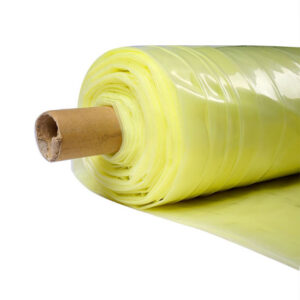
3. Width 5.5M, 8M, 16M. This not split but supplied as such to the grower
4. Roll length of 100M. The roll is cut as per client’s ordered length
5. UV treated. UV treatment blocks off excess UV light which in turn enhances the greenhouse paper lifespan. Our UV treatment is for 3 years/ 36 months. This warranty is on the paper
6. Anti-drip properties. Anti drip treatment prevents dew drop lets from forming on the greenhouse paper. Dew formation is as a result or crop respiration which releases moisture from the plant. Dew droplets falling or crops in the greenhouse pr-dispose the crop to fungal infections. The droplets also refract light, limiting the amount of light falling on the crop
How to choose your greenhouse polythene
- By crop. Is it a leafy or fruiting vegetable? Is is s mono or bi/ multi-coloured flower? This determines the paper color
- By width. There are different widths to choose from based on your greenhouse structure size
When the greenhouse paper tears, we provide a greenhouse repair tape that has the same characteristics as the greenhouse paper
FAQs
I. How much is greenhouse polythene in Kenya?
Greenhouse polythene price in Kenya
| Price | Treatment |
| Kes 95/M sq | With anti -UV only |
| Kes 120/M sq | With additional anti-drip treatment |
II. What plastic can be used for greenhouse?
Yellow or clear plastic are the choices for a greenhouse cover
III. What is the best poly for a greenhouse?
As explained above, the right greenhouse plastic depends on the crop type
IV. How do you attach polythene to a greenhouse?
For a metallic greenhouse, steel profiles and wiggle wires secure the paper against the steel frame
V. How long does polythene last on a greenhouse?
Our anti-UV block treatment is guaranteed for 36 months use. However, the paper itself will last for 5 years
VI. How thick should greenhouse poly be?
200 to 220 micron
VII. How often do you replace greenhouse plastic?
We recommend every 3 years so which is when the anti-UV block ceases
How to Keep Your Greenhouse Polythene Tight
- Spread out the paper on the greenhouse structure early in the morning or late in the evening when he temperature is below 20 degrees celcius. If it’s too hot, the paper will tear on contraction when it gets cold. If it’s too cold, the paper will sag when the temperature rises
- Roll it or pull it from one end to the next frame or runner and secure it with a profile and wiggle wire. Then stretch it again for this point to the next and so on
- Avoid covering in the afternoon when it is very windy as this will cause the paper to tear
How To Maintain Your Greenhouse Sheet
Observing these habits will keep your greenhouse polythene price in Kenya at the barest minimum
- Have a greenhouse tape for minor repairs when the paper is torn. Grekkon Limited’s greenhouse tape is UV resistant, trans-parent and is designed for outdoor use
- Clean your greenhouse cover monthly to prevent algae, moss, and dust which inhibit light from shining through
- Change it at the right time, which is when the anti-UV treatment expires
Caution: Do not use your greenhouse polythene in awater pan or tank to store or harvest irrigation water
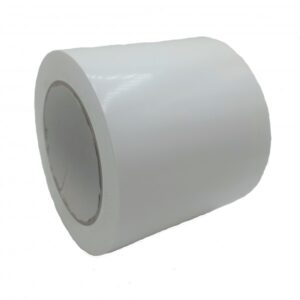
Greenhouse repair tape. It has the same qualities as the greenhouse paper
Greenhouse polyethylene price in Nairobi
This is Kes 96/ M sq in Nairobi and all our up country branches
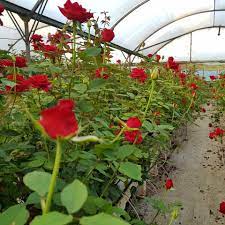
Low Cost Greenhouses In Kenya
Our low cost greenhouses in Kenya are either wooden or metallic in structure, vented or tunnel in shape. Internally, they will or will not have crop support systems, and the steel will be galvanised or painted with a protective coat
These low cost greenhouse construction in Kenya attributes are explained in detail below:
- Greenhouse size; the larger it, the lower the unit area cost
- Greenhouse material type. Wooden greenhouses are cheaper than steel frame greenhouses, because steel is more costly. However, they have a shorter lifespan
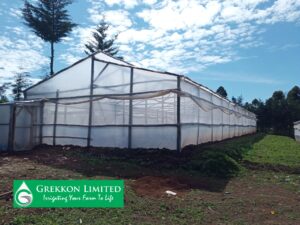
A low cost wooden greenhouse in Kenya by Grekkon Limited
3. Greenhouse design. Tunnel type greenhouses are lessor priced than vented types. The former are for cool highland locations so that they retain heat, while the latter are for hot locations for less build up of heat
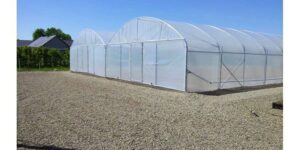
Tunnel type greenhouse
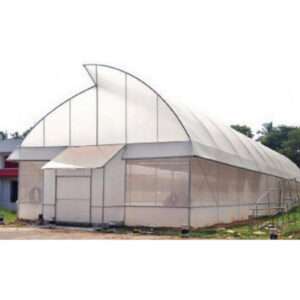
A vented type greenhouse structure
4. Greenhouse use. Is it for flowers, vegetables, strawberry, herbs and spices or seedlings production? This influences the infrastructure set up within the greenhouse. Crops that do not require a greenhouse with an internal crop support system such as; strawberry, herbs, and spices have lower greenhouse construction costs
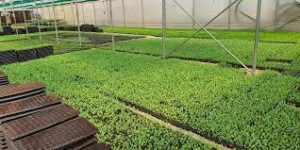
Seedlings production in a greenhouse
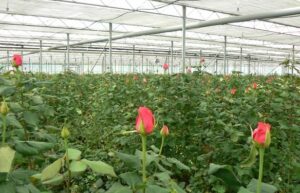
Roses production in greenhouse
5. Steel treatment type. To lower the cost of the greenhouse structure, some growers opt for steel painted with an aluminum or zinc coating. This is less costly than the zinc galvanised steel. However, the paint wears out over time and the greenhouse frame is repainted to prevent rust
As the leading greenhouse company in Kenya, we utilise local greenhouse construction techniques. Our low cost greenhouses in Kenya are for such crops as; roses, carnations, tomato, capsicums, strawberry, and assorted herbs and spices
I. Low Cost Greenhouses in Kenya
1. Greenhouse price in Kenya: Tabulation of steel types
| Greenhouse Type | ||||
| Tunnel Type | Open Ventilated Type | |||
| Greenhouse Sizes | 15M x 8M | 290,000 | 330,000 | |
| 20M x 8M | 300,000 | 340,000 | ||
| 24M x 8M | 320,000 | 350,000 | ||
| 30M x 8M | 460,000 | 540,000 | ||
| 40M x 8M | 575,000 | 655,000 | ||
| 15M x 16M | 460,000 | 555,000 | ||
| 24M x 16M | 620,000 | 665,000 | ||
| 30M x 16M | 900,000 | 990,000 | ||
| 40M x 16M | 1,100,000 | 1,240,000 | ||
2. Low cost wooden greenhouse prices
| Greenhouse sizes | Tomato Crop Population | Price in KES |
| 15 x 8 | 600 | KES 155,000 |
| 24 x 8 | 800 | KES 200,000 |
| 30 x 8 | 1,200 | KES 250,000 |
| 30 x 16 | 2,500 | KES 400,000 |
II. How much does it cost to install a greenhouse in Kenya?
Every tabulated greenhouse price in Kenya above by Grekkon Limited covers both the material and labor cost of greenhouse construction or installation
III. How profitable is greenhouse farming in Kenya?
Every low cost greenhouse for sale in Kenya procured for crop production is a significant investment for the farmer. To optimise revenue and ensure profitability, a grower will adhere to the following
1. Conduct a complete soil test. This will guide the farmer on 2 things
- the right crop nutrition regime
- and the suitability of that soil to establish a greenhouse in regards to any existing soil pests and diseases
2.Choose the right seed. Whatever crop you choose to grow, select the best yielding greenhouse varieties
3. Crop type. The value of the final produce according to market preference
4. Right greenhouse structure. This will be determined by the greenhouse location. Is it a vented or tunnel design?
5. Proper greenhouse polythene color and specs. Follow this guideline
- Yellow polythene is for mono color flowers or none fruiting crops which produce well under lower light intensity
- Clear polythene is for bi or multi colored flowers and any fruiting crop which requires higher light intensity for photosynthesis
- It will have UV treatment to last for long, and to block strong UV rays from reaching the crop
- It will be treated for anti-drip qualities. This prevents dew from forming on the paper and dripping on the crop causing disease infection
6. Irrigation management. As an irrigation company, we provide a detailed irrigation regime tailored to the crop type and growth stage
7. Disease and pest management.
- Have a sanitary pouch at the entrance to sanitize feet, and hands
- Limit access to the greenhouse to a few people
- Daily scouting for pests and diseases
- Have a scheduled pest and disease spray program
Greenhouse Sizes In Kenya
Greenhouse sizes in Kenya range from smal units of 120M sq, to large commercial structures spanning dozens of acreage. The most common greenhouse size in Kenya are tabulated below
Greenhouse Sizes In Kenya
A. Small
| Dimensions in meters | Tomato Crop Population | Price in KES |
| 15 x 8 | 600 | KES 195,000 |
| 24 x 8 | 800 | KES 275,000 |
| 30 x 8 | 1,200 | KES 365,000 |
| 40 x 8 | 1,500 | KES 530,000 |
| 48 x 8 | 1,600 | KES 600,000 |
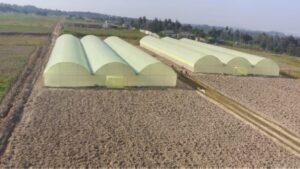
2,880M sq of greenhouses contructed for a medium scale farmer in Heni area, nyandarua county. The target crop is herbs and spices
B. Medium
| Dimensions in meters | Tomato Crop Population | Price in KES |
| 24 x 16 | 1,500 – 1,600 | KES 540,000 |
| 30 x 16 | 2,400 | KES 660,000 |
| 40 x 16 | 3,000 | KES 990,000 |
C. Large From 800M square. Kes 900 per meter square. We customise our price according to size, and your greenhouse budget
What determines greenhouse sizes in Kenya?
- Land area. The size of the greenhouse will be limited to the amount of land available to develop
- Water availability. The larger the greenhouse, the greater the water use
- Use. A seedlings propagation greenhouse unit in a fram will be smaller than the commercial units where these seedlings establish as crops in the same farm
- Budget. Greenhouse construction is a capital undertaking. The size of the greenhouse unit will be determined by the capital available
Greenhouse Sizes in Kenya
Construction materials
I. UV treated greenhouse polythene with anti drip properties
This is the key material that protects the crop from the elements of weather; sun, wind and rain. It creates the ‘greenhouse effect’, and minimises disease and pest incidences on the crop. It is either clear or yellow in color. Clear greenhouse polythene for fruiting crops, or in ornamentals, bi or multi colors. This is because it allows in more light which these need for photosynthesis, the process that makes food for the plants. Yellow is for vegetative crops, and mono color ornamentals. In mono color ornamentals, it intensifies the color
II. Galvanised steel bars
They provide structural support to the greenhouse, and also to the crop as ‘crop support structures’ for tall indeterminate crops such as; tomato, peppers, and cucumbers
III. UV treated high density insect nets
These nets keep away insect pests. They are for self pollinating (do not require external pollinators such as insects and birds) greenhouse crops
IV. Bird nets
These are only used in greenhouse crops that require insect pollination from bees, butterflies, hornets and many other pollinating insects. They allow in the insects, but keep away bird pests. An example of such a crop is strawberry
V. Profiles
They are screwed onto the galvanised steel bars so that the greenhouse cover is tucked in them
VI. Wiggle wires
Once the greenhouse cover is tucked in the profile, wiggle wires keep it in place so that it is not removed by wind or other physical force. Wiggle wires have a plastic covering to prevent damage to the greenhouse paper the are in direct contact with
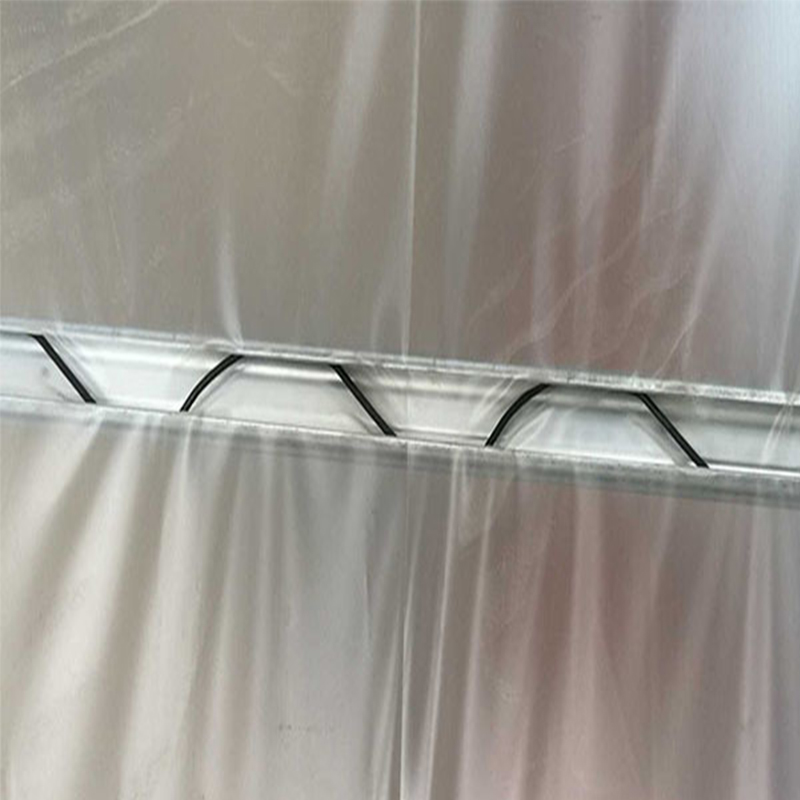
Wiggle wires hold in place a clear greenhouse polythene sheet tucked in a profile
VII. Screws
The join the profiles to the galvanised steel structure
VIII. Concrete
This is what supports the galvanised steel structures on the ground and keeps them upright
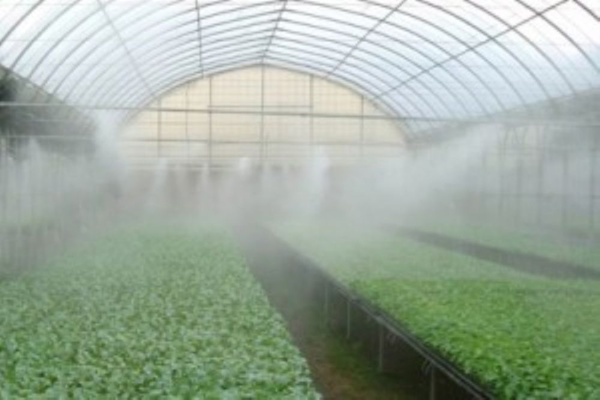
Humidification through misters in a seedlings propagation greenhouse
Successful greenhouse farmers in Kenya grow both none food and food crops in our metallic greenhouses. Common greenhouse food crops are; tomato, peppers, strawberries, and cucumber. Galvanised steel bars, insect netting, screws, and profiles are our greenhouse construction materials. With labor addition, all now constitute your final greenhouse cost Every Grekkon Limited greenhouse has a drip irrigation system for crop production, or a misting/ fogging system for seedlings propagation. Sprinkler irrigation systems are not installed in greenhouses
Greenhouse Sizes In Kenya
FAQs
1.What is greenhouse farming?
2. What is the most profitable crop to grow in a greenhouse?
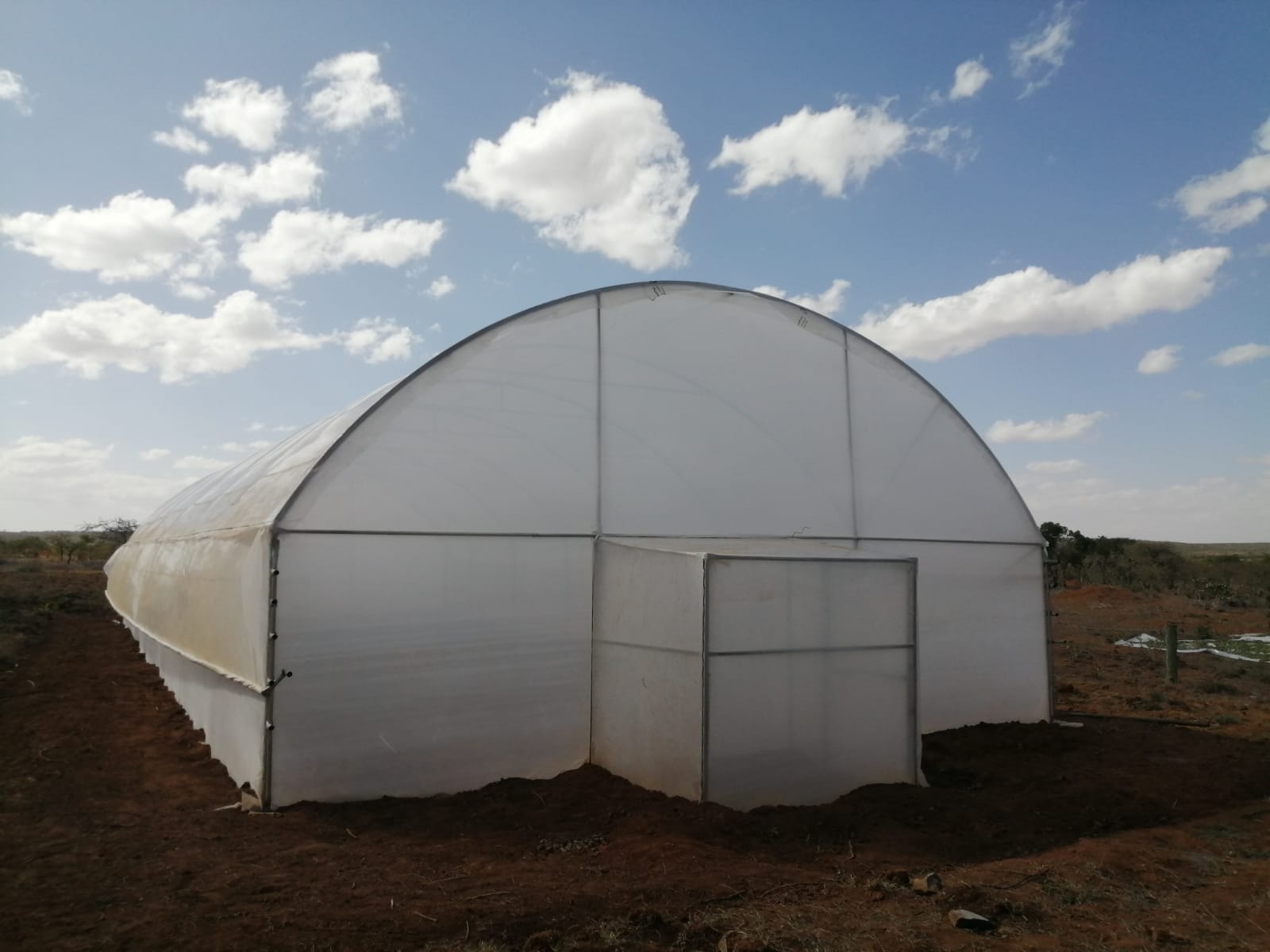
A 30M x 8M tunnel type greenhouse by Grekkon Limited in Rimuruti area, Laikipia county. Notice the front sanitary pouch, and side roll up
3. How profitable is greenhouse farming in Kenya?
Greenhouse farming consists of self-pollinating crops such as greenhouse indeterminate tomatoes, peppers, and cucumbers, and also insect-pollinated crops like strawberries. These are high-value crops that require intense attention and protection from pestilences such as; hail, drought, pest, disease, storms, and cold. They are moderately profitable. We design none food metallic greenhouses for flowers such as; roses, carnations, and chrysanthemums, and herbs such as geraniums, mint, basil, rosemary, and lemongrass. These crops are highly profitable and are grown by successful greenhouse farmers in Kenya.
4. How do you build a greenhouse?
Greenhouse farming in cool highland zones will have a tunnel-type greenhouse constructed because it conserves heat, while those in the warm lowlands will have a vented type greenhouse that allows better cooling. The difference between the two greenhouse types is that the vented type has a roof top ventilation. This is created by overlapping one side of the roof above the other (see the wooden greenhouse image below) Our sizes range are small, medium and large
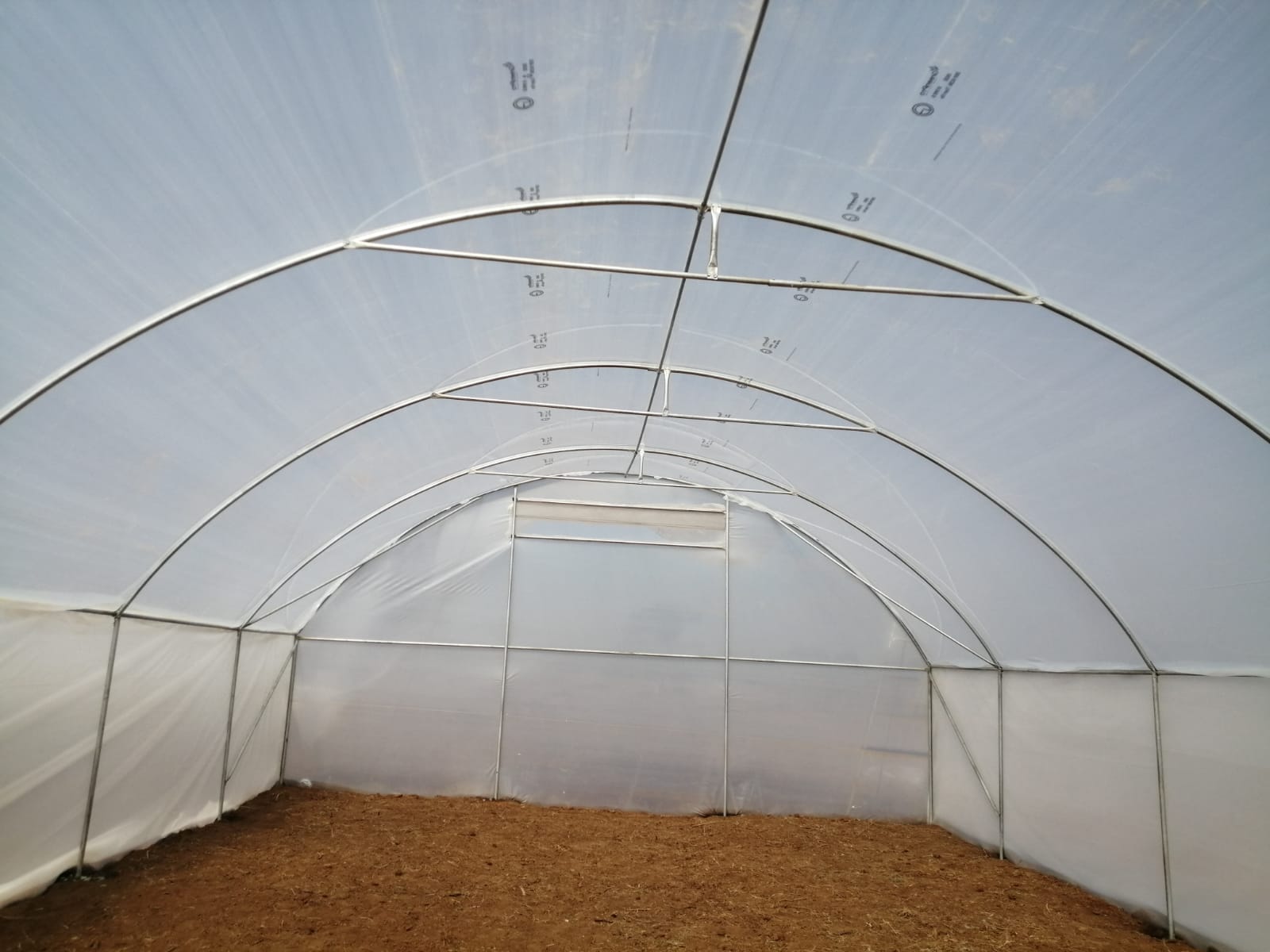
The interior of the tunnel type greenhouse
6.How thick does the plastic need to be for a greenhouse?
It will be 200 to 220 microns. Our greenhouse polythene price in Kenya is Kes 96/MSQ7. What is the best covering for a greenhouse?
8. Are greenhouse tomatoes better than outdoor tomatoes?
Greenhouse tomatoes have less pesticide applied to them because the crop is protected. Greenhouse tomato farming prevents high pests and diseases outbreak. These tomatoes have a lower shelf life than open field tomatoes because their rind is softer than open field tomato. Complete exposure to the sun is what gives open field tomato tougher rind, assuming the same level of nutrition for both. To increase the shelf life of greenhouse tomato, calcium and boron feeding is necessary
9. How well can a small-scale farmer run a greenhouse?
Grekkon Limited has developed manuals to assist small-scale farmers to achieve high yields in their greenhouses. We also conduct crop assessment visits during the first 4 months of production, free of charge. The reason we make it 4 months is because by this time, the crop has been harvetsed severally and the farmer knows all the basics of production
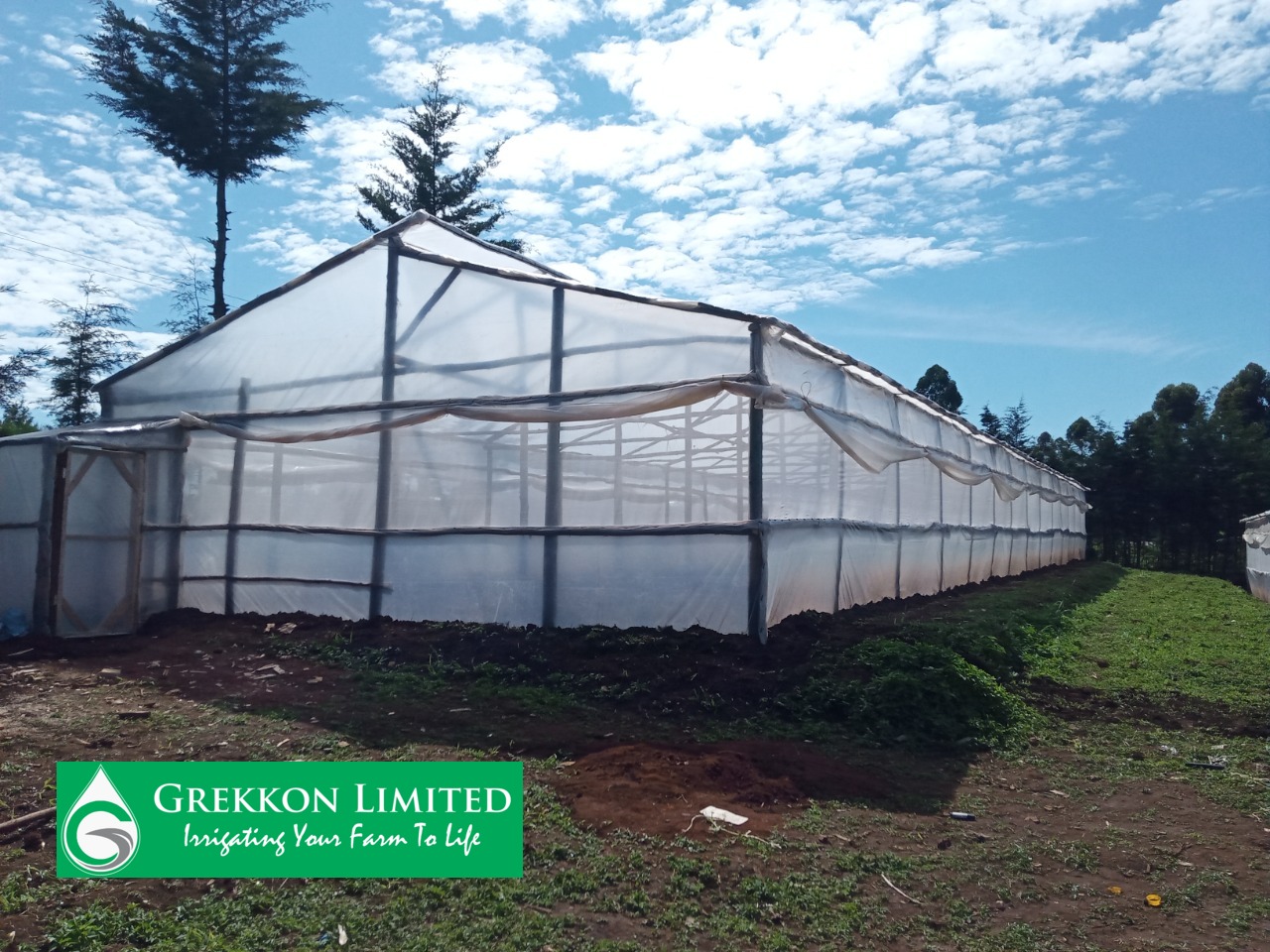 A low cost vented type wooden greenhouse in Kenya by Grekkon Limited
A low cost vented type wooden greenhouse in Kenya by Grekkon LimitedGreenhouse Sizes In Kenya
How profitable is greenhouse farming in Kenya?
How to get high yields in your greenhouse farming
1. Soil test
Conduct a soil test to determine the right fertiliser regime. A soil test will be done in a soil testing laboratory after soil samples are collected from the site.
2. Nutrition
Before making your beds, trench to 2 feet and add manure mixed with soil and ash then do your bed over this trench. This will feed your indeterminate crop for many months, providing consistent productivity
3. Water usage
Drip irrigation is the method of watering your greenhouses. Tomato farming, strawberry farming, pepper farming, herbs farming, cucumber farming, and for every crop in the greenhouse.
4. Crops to grow
Indeterminate vegetable crops like; tomato, cucumber, strawberries herbs, and peppers. This is because the yield over a prolonged period of time, which is key in returning the greenhouse investment
5. Pests and diseases
Greenhouses reduce the incidence of pests and diseases because the crop is under a protective greenhouse cover
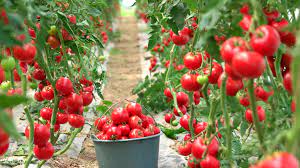
Ripe greenhouse tomato fruit

Ripe open field tomato fruits
Greenhouse Sizes In Kenya
Summary
For your greenhouse investment in Kenya, we provide a kit for an additional cost that consists of;
- Seedling trays
- Coco peat
- Fertiliser (planting and topdressing)
- Pesticides; insecticides (long and short PHI), and fungicides (preventive and curative)
- Personal protective equipment
- goggles
- gas mask
- overalls
- gloves
- gumboots)
- A 20-liter knapsack sprayer
This secures your greenhouse budget. Our technical team is at hand to guide growers on the best greenhouse cost and sizes based on; crop type, location, and budget.
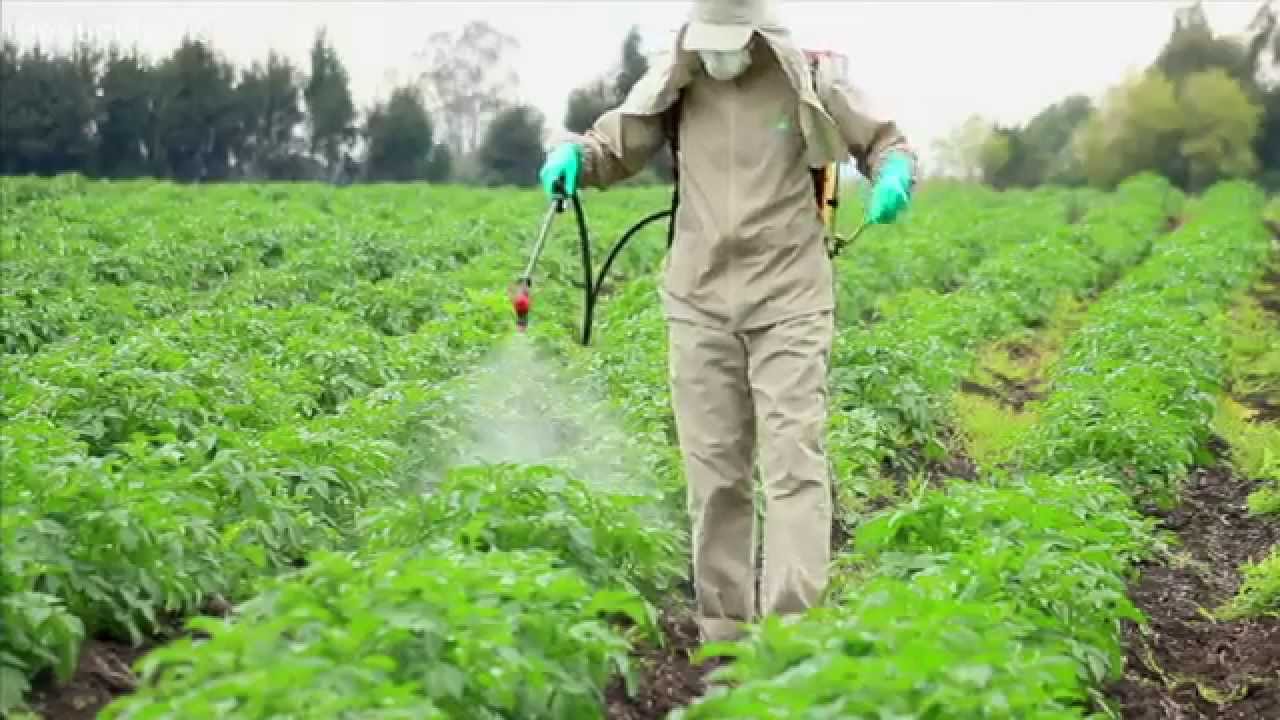
Spraying agrochemicals on a young open field tomato crop donning the full PPE kit
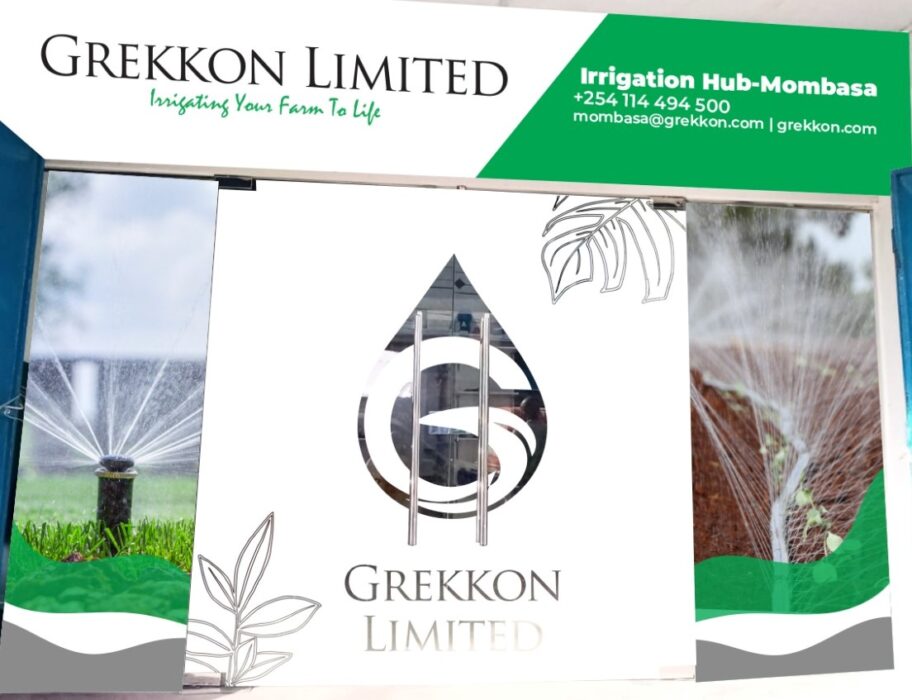
Irrigation Company in Mombasa
In commemoration of our 5 years of serving farmers, Grekkon Limited has a new irrigation company in Mombasa. Grekkon Limited – Irrigation Hub, Mombasa opened it’s doors on the 7th of February 2022. This is 5 years after the first office started operations from Nairobi. Grekkon Limited – Irrigation Hub, Mombasa is located along Jomo Kenyatta Avenue, opposite the Mombasa Pentecostal Church.
Irrigation Company in Mombasa
Products
Irrigation systems
1.1. Drip irrigation
- double emitter pre-perforated drip tapes for vegetables

tomato drip irrigation
- button drip irrigation systems for orchards, and forestry

button drip system on avocado
1.2. Sprinkler systems
- rain gun sprinklers to irrigate large diameters
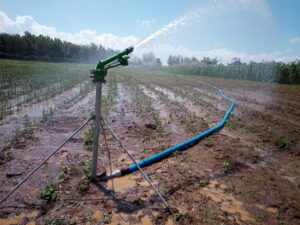
flange type rain gun sprinkler
- impact sprinklers for small to medium scale farms
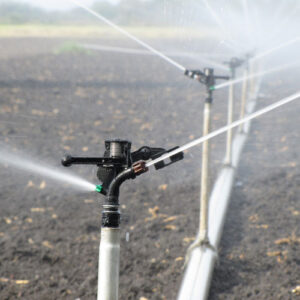
plastic impact sprinklers
- pop up sprinklers for lwans
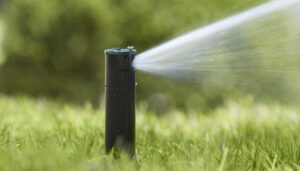
lawn pop up sprinkler
- butterfly sprinklers for small gardens and lawns
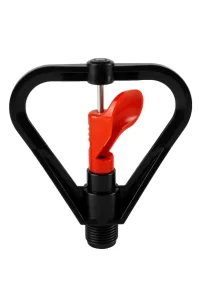
butterfly sprinkler
- meganet sprinklers
- micro sprinklers for lawns and orchards

micro sprinkler
1.3. Rain hose kits. These are pre-perforated pipes through nano technology that provide overhead irrigation

rain hose irrigation system
Every irrigation system comprises of a main line and/or a sub main line. These pipes are either high density polyethylene pipes (HDPE), polyvinyl chloride pipes (PVC), or PVC delivery pipes. Every pipe type has it’s own fittings
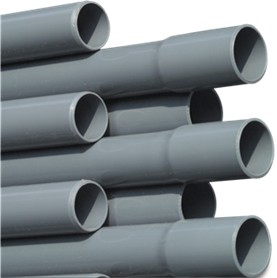
PVC Pipes by Grekkon Limited
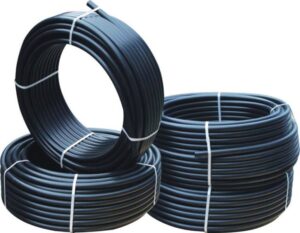
16mm HDPE pipes
2. Dam liners
These are UV treated HDPE geomembranes as;
- 0.5mm. for fine textured surfaces
- 0.75mm. for surfaces with murram
- 1mm. for rocky/ stony surfaces
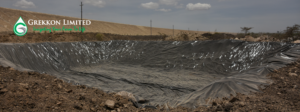
a dam liner on a reservoir
3. Greenhouses
They are categorised by shape, and/or by main frame material
3.1. By shape. They are either tunnel type which are constructed in highland or cool locations. Or vented type done in warm or mid-low altitude areas
3.2. By structural material. They are either steel or wooden. All wooden greenhouse are ‘vented types’

a steel frame, tunnel type greenhouse
4. Solar dryers
These are crop drying units made from galvanised steel with a UV treated polythene paper cover.
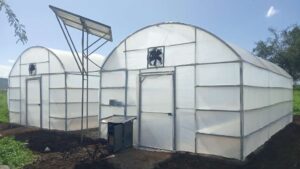
solar dryers in Taveta by Grekkon Limited
5. Water pumps
5.1. Solar water pumps for shallow and deep wells
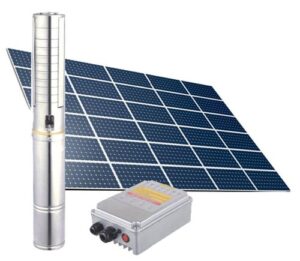
solar water pumps
5.2. Electric surface and submersible pumps

electric surface water pump
5.3. Diesel generator water pumps
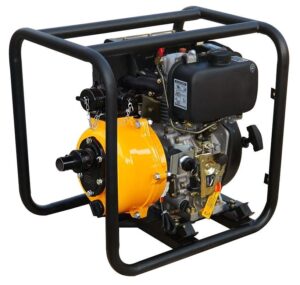
diesel water pump
5.4. Petrol generator pumps
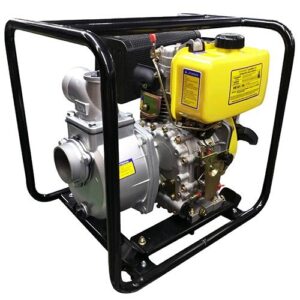
6. Agriculture nets
6.1. Shade nets. They shade the crop from excess sunlight. They are supplied as; 30%, 55%, 75%, and 90% shade
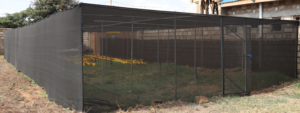
a shade net structure
6.2. Insect nets. They protect the crop from insects. They are supplied as light or heavy gauge
6.3. Bird nets. They protect the crop from bird pests
7. Planting trays and coco peat
Planting trays as; 28, 50,66, 128, 200, and 288 cells for all crops. These come with coco peat planting media
Irrigation company in Mombasa
Service
We provide tailored agronomy support service to all our farmers in east Africa. A detailed crop production hand book detailing all key aspects of crop production is given in every project
